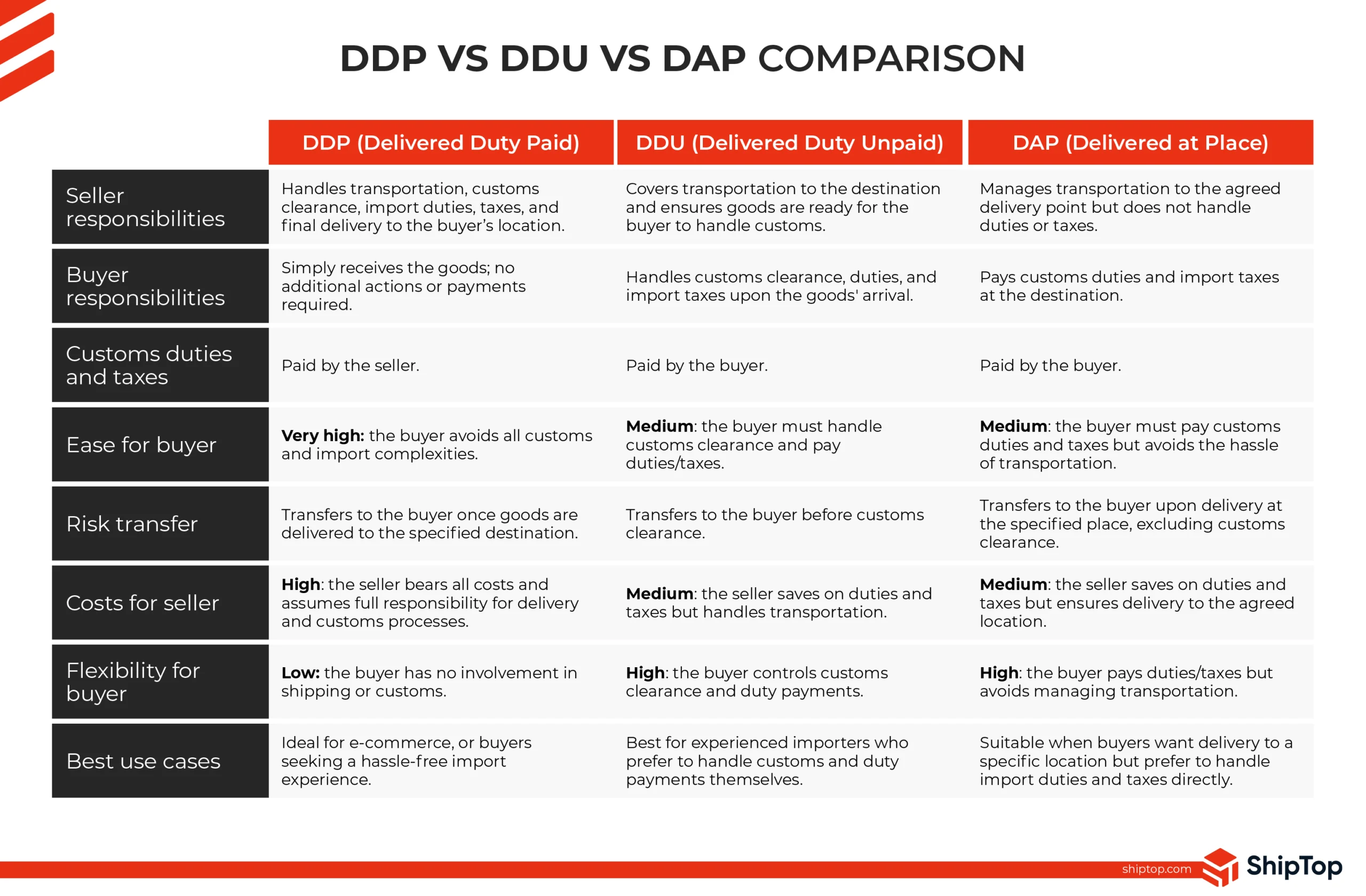If you’re part of the international trade, then there is a good chance you’re familiar with Delivered Duty Paid shipping. DDP is one of several International Commercial Terms (also called Incoterms) — which represent internationally recognized rules that define the responsibilities of buyers and sellers in trade contracts.
The focus of this post is to shed light on the inner workings, benefits, costs, challenges, and use cases for DDP shipping.
What is DDP shipping?
DDP (or Delivered Duty Paid) is a shipping arrangement where the seller assumes all of the responsibility, risk, and costs associated with transporting goods until delivery. When it comes to global trade, DDP has become a standard shipping method.
Under DDP, the seller covers:
- The transportation costs
- Import duties, taxes, and customs clearance
- Other expenses throughout the transporting of goods and until the time of delivery.
The International Chamber of Commerce developed DDP to standardize and improve international shipping. At its core, DDP shipments favor the buyer because they assume fewer costs and less liability.
In line with DDP, each country has its own customs rules and policies for international shipping.
For instance, a US seller shipping products to Canada will have different requirements than a US seller shipping products to Europe. If you do run operations throughout the EU, you will have to deal with VAT and other requirements, which can vary from one EU country to another.
Incoterm differences: DDP vs DDU vs DAP
DAP (Delivered at Place), DDU (Delivery Duties Unpaid), and DDP are three common trade terms that determine where the shipping responsibilities lie between a buyer and seller.
- Under DDP terms, the seller takes care of all costs, risks, and responsibilities until the shipment is delivered to the buyer. The buyer only pays the price of the goods and delivery.
- Under DDU terms, the seller is responsible for delivering the goods to the buyer’s destination but does not cover the payment of import duties, taxes, or customs clearance — these costs are left to the buyer. DDU offers flexibility for buyers who prefer to handle their own import arrangements, but it lacks the convenience of DDP.
- DAP shipping is where the seller covers transportation costs but not import duties or taxes. With DAP, the buyer pays customs duties and import taxes when the goods reach their country.
Here’s a table for easier comparison.

How to calculate DDP shipping cost
When using DDP shipping, several key factors can impact the total costs for sellers. Some of the main ones include:
- Destination country and customs requirements: Shipping to countries with complex customs procedures or high duties/taxes will be more expensive. For example, DDP shipping to Brazil and clearing items through customs there will likely cost more than shipping to Canada.
- Type of products: If you are shipping high-value electronics or luxury goods, the import taxes applied will be higher, driving up DDP costs. In contrast, shipping clothing and other lower-value goods will have lower taxes. Restricted, hazardous, or sensitive items will also boost costs.
- Shipment size and weight: As with any shipping method, the bigger and heavier the shipment, the higher the base transport costs will be. With DDP you also often pay duties as a % of value, so larger shipments get exponentially more expensive.
- Seller’s experience: Having an experienced logistics team that has regularly shipped to the destination country using DDP will help optimize the process and lower costs through volume discounts and other efficiencies.
Calculating DDP shipping costs involves understanding and accounting for all expenses you will incur to deliver goods to the buyer’s specified location. Aside from the list above, you should include things like packaging costs, insurance, and currency exchange rates.
To assist with this calculation:
- Some countries provide online tools to estimate duties and taxes.
- Freight forwarders and brokers can usually provide detailed cost breakdowns.
- Various shipping software, if you’re using one, can help you calculate all-inclusive shipping costs.
Recommended read: Reduce Shipping Costs by Partnering with a 3PL
The challenges of DDP shipping for sellers
When a seller uses DDP shipping, they take on all responsibilities and risks associated with the shipment. This comes with certain challenges:
- Customs requirements: The seller must have expertise in classifying goods, providing documentation, calculating duties and taxes, and meeting import regulations in the buyer’s country. For a seller new to international shipping, navigating these customs procedures can be daunting.
- Penalties: Under DDP terms the seller is liable for any penalties, delays, or other issues that arise during customs clearance. If there are problems with missing paperwork or inaccurate information, the seller will bear the brunt.
- Duties and taxes: Perhaps the biggest downside for sellers is that they must prepay duties and taxes in the origin country before export. If duties and taxes in the destination country are high, it can greatly reduce how much profit the seller makes on the sale.
Despite those challenges, in the following section, you’ll see that there are many good reasons to opt for DDP shipping.
Deciding if DDP shipping is right for your business
DDP shipping might make the most sense for your business if you meet some of the following criteria.
You are shipping high-duty items abroad frequently
If you regularly ship products overseas that tend to have higher import duties and taxes, DDP can help simplify the process. With DDP, you handle the duties upfront rather than your customer. This avoids any surprise fees or headaches for them when the package arrives.
DDP is ideal if you sell high-duty items like alcohol, tobacco, perfumes, electronics, or luxury goods abroad. A rule of thumb can be opting for DDP shipping for items above $50.
You want to streamline the process for international customers
Do you get complaints or concerns from overseas buyers about getting hit with customs bills? Or find international sales lagging because buyers are daunted by duties?
DDP saves your customers from dealing with customs and paying import taxes upon delivery. This can encourage greater international sales. With DDP, the entire duty and import process is handled — hopefully seamlessly — by you.
You’re experiencing low conversion rates
Some industry research suggests that offering Delivered Duty Paid shipping can improve international sales conversion rates by up to 20%. This improvement is attributed to the elimination of unexpected fees upon delivery, fostering a seamless purchasing experience that builds customer trust and satisfaction.
You want to avoid customs bottlenecks
There’s no denying that DDP involves some extra administrative work on the seller’s end. You’ll need to accurately assign HS codes, calculate duties owed, fill out forms, etc. But if you have the resources and capability to take this on, the benefit is a simplified process for buyers.
For sellers, DDP provides more control and can speed up delivery by avoiding customs bottlenecks.
Final thoughts
For companies positioned to take on the initial extra costs, providing DDP shipping can be an investment in future international growth. The effort involved in coordinating DDP shipments is outweighed by the customer satisfaction — and expansion it allows.
If you sell goods abroad, strongly consider making DDP shipping part of your strategy.
Still unsure whether DDP shipping is right for your business? Connect with ShipTop’s shipping experts and get a free consultation.






